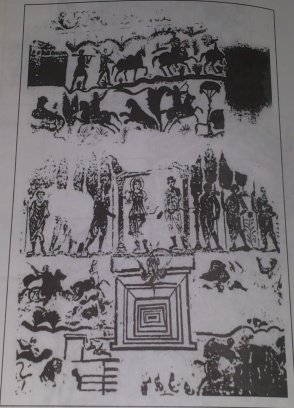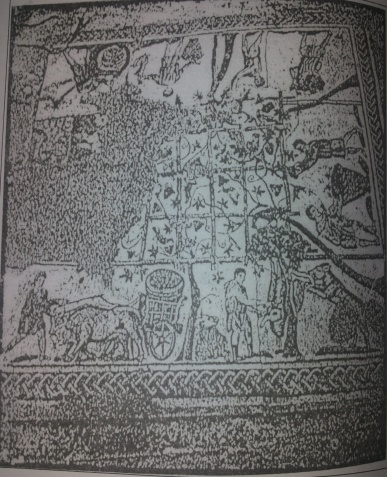Description of three North-African mosaics illustrating the theme of offering.
North-African mosaics rate as a highly significant archaeological source. The imagery develops a range of themes driven by the origins and tastes of incoming Romans or Romanised Africans who had adopted the rites and customs of the Northern conqueror. Overall, the theme of offerings to the gods is not hugely represented but a few examples will help illustrate it.
The mosaic of the sacrifice to Diana and Apollo, site of Carthage (Tunisia)
We have here a representation of crane hunting dating from the 4th century, that is to say the late antiquity. The mosaic shows a hunting scene at the centre of which can be seen a statue of Apollo[1] , alongside that of his sister Diana[2], goddess of the hunt. They both stand inside a tetrastyle building foregrounded by an altar. To the right of the sanctuary (the left of the viewer), the hunters stand in line, haloed, identically dressed; they have adopted similar attitudes after depositing their offering – the eponymous crane – on the altar. In the ancient mindscape, cranes were thought to belong to one of the finest bird species, making the offering the more precious. This central scene of religious worship is set between other scenes trailing the hunters from the off with their attendants right up to a fight with tigers, via the stalking of quarries (boars, dear, lions). The lower register details how some horsemen attempt to coax a lion into a cage by baiting it (with a kid goat) in order to goad it into the trap.

 Informations[3]
Informations[3]Wine harvest mosaics, site of Cherchell, (Algeria)
The mosaic discovered at Cherchell shows vineyards where grapes and vine leafs are closely interwoven. On the surrounds of the centrepiece, scenes evoke grape picking, the filling of the baskets, the transportation of the grapes to the cellars for crushing, pressing and fermentation. The stages depicted include the sacrifice of a skinned ram shown beheaded and hung bleeding upside down as an offering in the honour of Dionysus.

 Informations[4]
Informations[4]
 Informations[5]
Informations[5]





